
Issue #: 147
Published: May / June 2016
- Price per issue - digital : 5.40€Digital magazine
- Price per issue - print : 6.20€Print magazine
- Access to Multihulls World digital archives Digital archives
On board Jaganda, Olivier and his family are preparing for their arrival in New Zealand. It's been a lively crossing, and will mark the halfway point of their round the world voyage…
Setting out on a round the world journey and all the unknown pleasures which it will offer, also means understanding that one will have to accept confronting the vastness of, and sometimes a duel with Mother Nature. It's about understanding that one day we will have to face the uncertainties of an existence which we had wished for in an attempt to get away from the humdrum, everyday, politically correct and socially conforming projects of our life. But setting out isn't about running away either. Only those die-hard stay at home folks who have never set out and never will, are likely to say it is, misunderstanding what those who do dare to leave are all about. No - setting out isn't running away, it's all about taking on a challenge. And it begins with challenging oneself. Some people won't go any further than that, as this act alone implies courage, determination, steadfastness and enthusiasm.
I obviously talk a lot about our stopovers. However, if we want to get around the world by boat, there has to be some sailing involved! You leave your wake on the seas. Stubbornly. Mile after hundreds of miles. Over weeks and months. It's not always easy.
However, there is a kind of handbook for dealing with this kind of rediscovered freedom. Making sure that you're always in the right place at the right time is one of the golden rules. Another is to never be overcome with doubt. But, each to their own. Long ocean crossings aren't really my favorite thing. Don't get me wrong, I don't mind them. I love being out on the high seas. However, I prefer the shorter trips between stopovers, the arriving and the sailing along deserted coastlines looking for shortcuts. I especially enjoy feeling at one with Nature. Something which seems to be forgotten more and more these days.
One of the more delicate stages for a catamaran that is doing a round the world voyage, along with the passage around South Africa, is the trip between Tonga or Fiji and New Zealand just before the Pacific cyclone season starts...
I have vivid memories of our trip having left Tonga. It became particularly eventful around 40° South. I remember thinking how wonderful it would be to see the green fields of New Zealand. For some while, Jaganda's navigation system had been showing that we were closing in on 180° West (or East!), and that we had almost covered 18,000 miles since leaving France. It was late October, and we needed to start thinking about leaving the tropics, and staying out of the western Pacific cyclonic zone for 5 months by heading further south, out of danger, in the "land of the long white cloud".
Ahead of us lay a direct route 1,125 miles long, and then at around half way through our voyage, we had planned a stopover of several months.
Our first sight of the landscapes of North island, New Zealand…
The favorable weather window which we were waiting for looked as though it was in place. An anticyclone straight from Tasmania was heading for the East of the Southern Pacific. If its trajectory was confirmed, then it should, in theory generate winds from the south east, east, north east and then north along our path. Ideal! Our plan was to set off as the anticyclone arrived, so as to allow the winds to get us to the other side well in advance of the deep and no doubt fearsome depression which would surely follow on behind… We stocked up with a minimum of provisions at Pangai, the main village of the Ha'apai Islands, because the Health Inspectors in New Zealand have the annoying habit of disposing of all of your food when they carry out their initial inspection on arrival in their ports. And in an effort to avoid the over-zealous customs officials getting rid of the top notch Mirabelle (yellow plum) liquour made by my father, I decided to finish the bottle before arriving. To facilitate this, and despite the paternal crisis that it could have caused, I decided to mix it with some cane sugar, slices of Tongan bitter orange (there are no more limes) and a little orange juice. This goes down well and replaces the punch, which had not made an appearance on board since we had run out of rum. In other words, for ages.
The previous night I had had trouble picking up the Firefly station in Australia. I was impatiently awaiting the latest weather updates before launching into the cry that the long haul sailor, stuck in the immensity of the southern Pacific, longed to hear: Banzai! At around 2am, I finally realized why there was no reception: one of the two open aft lines which allowed access to the port transom was touching the antenna and was acting as an earth. Once resolved, I could immediately pick up Firefly and the weather forecast. The wind had arrived. We could light the blue touch paper…
After a few hours of steaming along, the south easterly breeze had turned around by 10°-15° and had dropped slightly. With one reef less, and the power of the mainsail back in the mix, we were on course for Whangarei, 207°. The crew is together, and all looking forward to spending time on the green, green Kiwi prairies…
That night was superb, the sea was calm, and the moon, full and magnificent, accompanied us throughout our transit. She had risen yesterday evening before the sunset, she disappeared this morning with the first light of day.
Leaving Tonga for New Zealand. Heavy on the starboard side!
The wind and the sea had picked up. 20 to 25 knots. There was enough sea to ensure that our catamaran's bows were plunging into the waves. It was a good contest, lively and a little rough. Our speed was 8 to 9 knots. It had also started to cool down, and we had to put on our fleeces. We would be leaving the tropics the next night (23°27' south). Today, the salon was like a reading room. We didn't see another craft all day. A few sea birds: Brown Noddys; White-Tailed Tropicbirds and Gannets. Only the sea: immense and empty. We were headed for the southern latitudes, where it was still only the Springtime.
It's worth mentioning from the outset: Barbara had taken an immediate dislike to the Grib files, weather forecasts, and I reckon, weather forecasters too! One of whom was the famous Bob (MacDavitt), the Kiwi pope of regional weather forecasting. Unfortunately, it looked as though I had been lumped in together with the other forecasters… So with the wind hitting us forward of the beam and gradually gaining in strength, I was not flavor of the month! This was not what had been forecast! 2 reefs in the main sail for the night, some solent, and waves over the forward beam. It's time to get on deck. We get stuck in. It's wet and starting to get decidedly chilly. I squat in the starboard side of the salon for the night, next to the chart table. I prefer to be ready to jump into action. However, I'm not alone on watch. There's little blond Adélie too. She hates the thought of being stuck in a hull when a boat is being tossed around on the sea. She sticks to the port side of the salon throughout the night. Just before falling into a deep sleep, she tells me that she's "on watch". Wonderful. The peaceful and angelic sight of my daughter, hugging her favorite cuddly toy, clashes with the sea crashing against the forward coachroof windows and then streaming away, whilst our catamaran pushes on at 9 knots into the dark night…
Day broke with the sea looking menacing: a four meter swell and 30 knots of wind. We were not sad to see the back of the Minerva reefs. Approaching the reef in this kind of weather must be pretty frightening. I had hoped to sail through it in calmer waters, but that will have to remain a dream!
Extract from Barbara's journal, written during one difficult day during the crossing:
« I won't beat about the bush. I hate this kind of crossing. Sudden movements. Constant reefing, the deck getting sprayed, waves attacking the very structure of the salon, the hulls racing down into the waves, the claustrophobia of the salon… And then, when the wind calms slightly, despite still blowing at over 20 knots, and the boat is "only" sailing at 8 knots, and I have time to catch my breath, the voice of the Captain breaks my moment with a cry of: "The wind's dropping, we're losing speed"! On a crossing in difficult conditions such as these, I admit that my mood is dark, black even. I feel trapped, vulnerable, and worse, I take no pleasure from seeing our boat move across the ocean. I put up with it and vent my anger on the elements, weather forecasters, even the Captain and even myself for not being better at putting up with the conditions. So I watch my children, completely stoic, ensconced in the salon with their book or DVD player. They are always in the same mood, and I am jealous that I am not the same. Of course, they don't feel how I do, worried to my core that something might happen to the captain during these difficult crossings… No, the lucky so and sos don't have that worry. Still, in a couple of days we should see the coast of New Zealand, and all this will just be a bad memory that can be forgotten. Before our next perfect trip, as the Skipper likes to present them before we set sail…"
People are always the most difficult things to get a handle on. It's true that the sea isn't always blue on a round the world voyage. One of the other golden rules is that for a journey to continue, nobody must lose heart and switch off over a long period of time. There was no doubt in my mind that when we would be moored in the still waters of the Wharangei River, right in the town center, 15 kms from the sea, that a hot cup of earl grey and some chocolate treats with Barbara in the best tea room in town, would be the only thing to do…
Tonga-New Zealand: one of the more delicate passages of a round the world trip…
During our lunch (marlin from Mopelia with an excellent curry sauce and fresh vegetables) eaten quickly from a bowl, the reefing pendant broke. When this happens, Marin and I strip off (otherwise we get soaked and it takes ages for our clothes to dry after they've been rinsed) and "banzai"! We get stuck in. I pass a new line through the boom and send back the sail. In the afternoon, the wind dropped thankfully. It dropped back to 20/22 knots and turned around another 20°! The forecasters were pretty much right, just slightly out on their timing! Now the wind was 90° to port with the true wind just off the beam and the sea too. The boat seemed to appreciate this, slipping through the water with less bumping, gliding along at 9 or 10 knots without fighting against the elements. Everyone felt better. We had left the Tropics behind, and were heading for the 180th Meridian. We had been used to the westerly longitudes for a long time. The change will seem strange!
After two cloudy, damp and grey days, at around 7.45am the sun began to break through as we crossed the 180th Meridian. The thermometer carried on dropping. I managed to take a photograph of the GPS reading which showed a longitude of 180° followed simply by zeros! I watched how it did it: the sat nav changed normally, and then began to count down the longitude. It had been counting upwards for a long time until now. There must be a seriously good calculator in there! The most amazing thing was the electronic chart. On my route that I had set out between Tofua and Whangarei, I suddenly saw that at the instant where we touched 180° of longitude, the red line shot off East for a quick round the world tour before settling back on 207°, our route to New Zealand… I just had to do a quick reprogramming to East longitude, and everything was back in order
Jaganda's chart table: the center of activity…
I knew that the end of our crossing would be a little more difficult to manage than the start, with more unreliable and lighter winds. But I'm not going to complain. It was a key element in our Pacific crossing with a particularly tricky weather window to negotiate. It was all about not getting caught up in one of the frequent gales that blow up in those parts. The area of ocean 1,000 miles to the north, between New Zealand and Tonga and Fiji has been responsible for the disappearance of several yachts caught up in exceptionally bad weather. I kept this in mind. In the end, the window that we chose proved to be ideal, allowing us to do a rapid 6.5 day crossing from Tofua.
Today we saw a huge albatross, majestically circling. It was the first sighting of our southern trek. The fortieth parallel couldn't be far away! The Kermadec Islands, to the East of our position, are one of the major breeding grounds for these southern birds who have no fear of the storms.
After 6 days at sea, just off the New Zealand coast, I spotted the Poor Knights Islands just after breakfast. The wind had gradually dropped, and by 5am had gone completely. At around midnight we had replaced the solent with the blue gennaker. The cold was more obvious, with just 15°C in the middle of the night. I dug out my socks in an attempt to avoid the humid cold that had got hold of me the night before in the salon. Barbara had promised to get the duvets out. They had been vacuum-packed months ago in waterproof bags. We crossed a New Zealand trawler out fishing. It was a solid boat, made for coping with storms. The sea water had turned dark green. It was full of plankton, and since the morning, we had spotted small penguins bobbing on the surface and then diving as we approached. There were lots of big Kermadec albatrosses too. In the morning, they circled around our boat, no doubt hoping to pick up any bits of food (biodegradable of course) that we might have thrown overboard. At around midday, dolphins came out to welcome us to New Zealand. The coast of the North Island started to become visible to our starboard side
As the local rules require, we announced our arrival via VHF radio. As elsewhere, there was no question of putting a foot on land before receiving our clearance. Since that morning we had been looking for any dead insects on board, and cleaning, washing and tidying. We didn't want anything to upset the New Zealand biosecurity agency inspector. We were approaching Bream head, the rocky outcrop which juts out into the river Whangarei Estuary. Within 2 hours we would be in the Customs berth of Marsden Cove, New Zealand! Barbara was smiling again. The crossing was already over. The kids were beaming. We were all set for a long stopover on the other side of the world!
Heading South West, the weather deteriorates…
We passed bream Head at around 3pm and headed for the channel. Visibility was incredibly good. The albatrosses were still circling over our wake. We had an hour to go. Just enough time to get to Marsden Cove before the current turned. We passed a few small boats that were fishing in the estuary. The green hills were only a few hundred meters away. What a change of scenery! We could see cows, sheep and houses surrounded by flower-filled gardens and yachts moored up in each small bay. Although expected, these first scenes really excited us. We spotted the narrow channel which led to Marsden Cove, one of the places authorized by the government to carry out entry formalities. The end of one dock is reserved for boats that need to get their clearance. It is surrounded by impenetrable barriers, and it's here that any boat arriving from abroad must dock. This is the Customs Berth, or the quarantine quay. This is Flag Q in the International Maritime Signals Code. We are not allowed to disembark while awaiting the arrival of the authorities. I learn through the VHF that the visit won't take place until the next morning, given the late hour of our arrival. I immediately realize that my first swig of Steinlager with Barbara at the nearest pub is going to have to wait a bit... With the southerly wind now blowing, the weather was actually pretty cold. As I wasn't able to go and have a drink, I began a mega desalination of the boat, making the use of the water pipe on the quarantine quay which had enough pressure to reach half way up the mast. Simple pleasures indeed! Our catamaran seemed to breathe a sigh of relief. Night had fallen long before I finished the job. I was soaked to the skin and freezing cold. The boat was clean, and we were half way through our round the world voyage. I headed for bed and fell asleep immediately. The thought of a full night's sleep docked on a quayside in calm waters is just too good a chance to miss…
Crossing the 180th Meridian…
The New Zealand Customs Officer, who also assumed the role of immigration controller (unimaginable in France) arrived at 9.30am the next day. The officer was very pleasant and very professional. He had received both of my emails and he already knew everything about the boat and its crew. I had already filled in the papers that the New Zealand government makes available to sailors wishing to head for New Zealand. These can be found in various administrative offices around the Pacific islands. We had picked up the documents in Tonga. Everything went quite quickly. The officer explained to me the customs status of the boat while in New Zealand, and indicated the maximum duration of stay allowed (12 months, renewable upon demand). He then calculated for me, on a form which I signed, the amount of tax which would be due should the boat ever be imported into New Zealand. In short, compared to the way we do things at home, which is essentially repressive (which ends up making cheating a national sport), here the authorities lay their cards on the table. It seems to me to be a much more intelligent way of operating. The officer then spontaneously gave me a VAT tax slip which allowed me to make any purchases for the boat without paying the VAT.
I was then asked to confirm what I had declared. I reread it, agreed and signed. He was satisfied. He stamped our passports (a 3 month renewable visa), did a quick tour of the hulls, announced the imminent arrival of the biosafety official, and left, wishing us a good stay. He was quite simply, the most pleasant customs official that I have ever dealt with!
His colleague, a robust woman, was just as friendly. She took all the pre-prepared documents, read them carefully, and quickly asked to see the galley and storeroom. She opened a large, solid, black rubbish bag, and (after excusing herself) puts into it all the fruit and vegetables which were left from Tonga. And the eggs too. Straight into the trash. She would have taken the honey too had we had any. Meat too, especially meat, but we didn't have any. She repeated her question, but we confirmed that we didn't have any. Not even the most disgusting tin of corned beef. We explained that we knew that any meat would be destroyed upon arrival, so we made sure not to have any. I also explained that we mainly ate fish, and that we had on board, under our feet, some glass jars of preserves, home-sterilized, UHT style. Sailfish from the Atlantic, and Marlin from the Pacific. The choice is yours. I lifted the floorboards of the starboard hull and showed her the pots that were stored there. I had had the awful idea that we would have to throw them away upon arrival. There were around 20 or so left. To our surprise, our home-made fish preserves didn't pose any problem for her. She let us keep them! I couldn't believe it! The visit was over. She put the black rubbish bag inside another similar one, carefully tied the knot and set off for the quarantine quay and her vehicle with her meager biosecurity pickings. She left with a nice smile, and wishing us a happy stay with the Kiwis. Her visit hadn't lasted for half an hour. And we had been so terrified of this visit, that we had picked up every insect that had met its death on Jaganda…
So, with the current still flowing upriver, we set sail for Whangarei, capital of the Far North… We would soon have the green prairies of New Zealand within our grasp!
The sun returns, the wind drops, and the Noddys are tired…
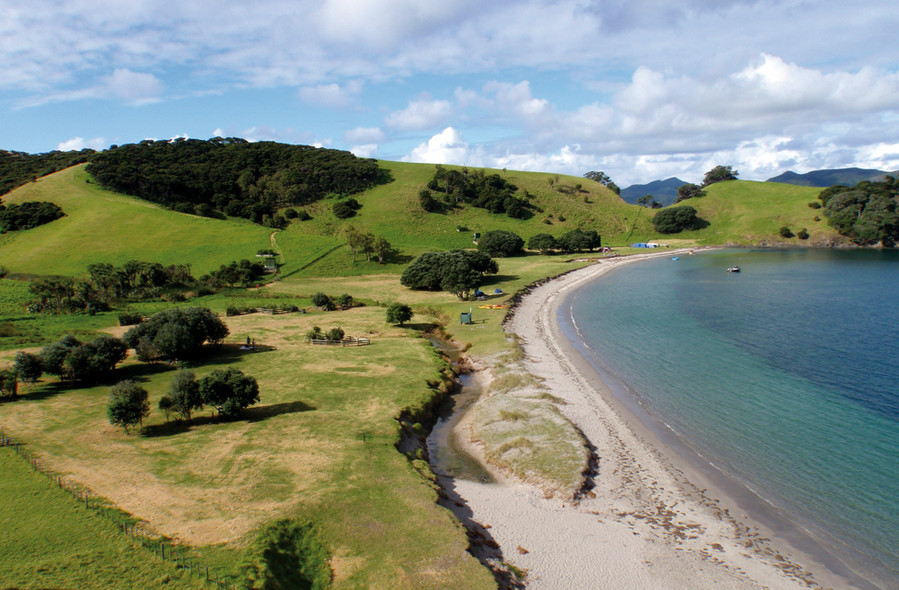
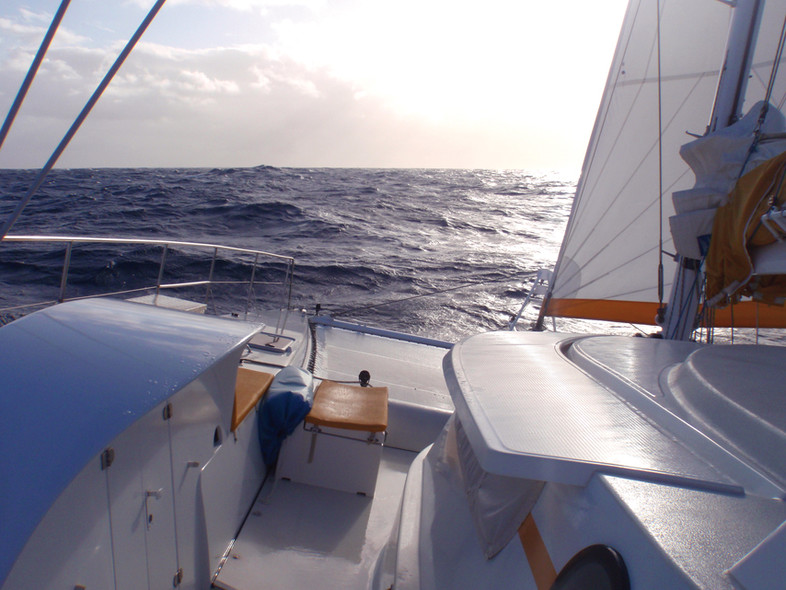
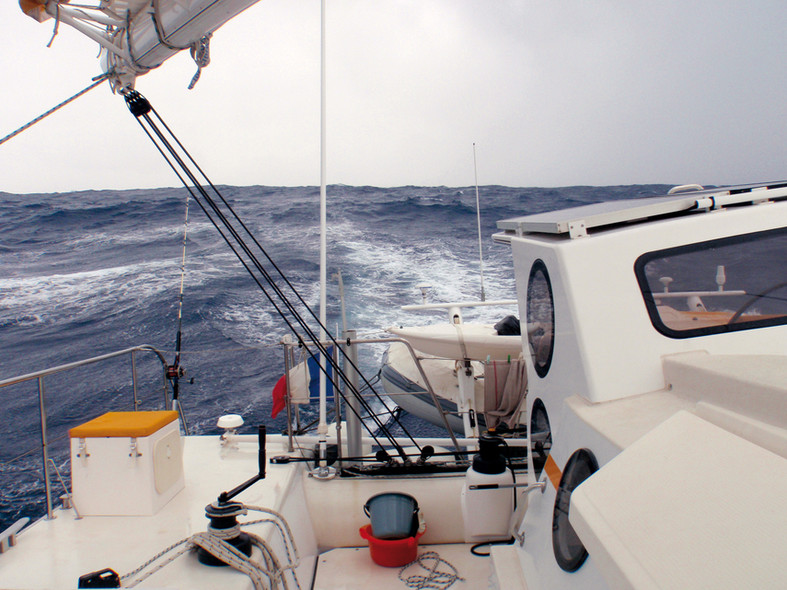
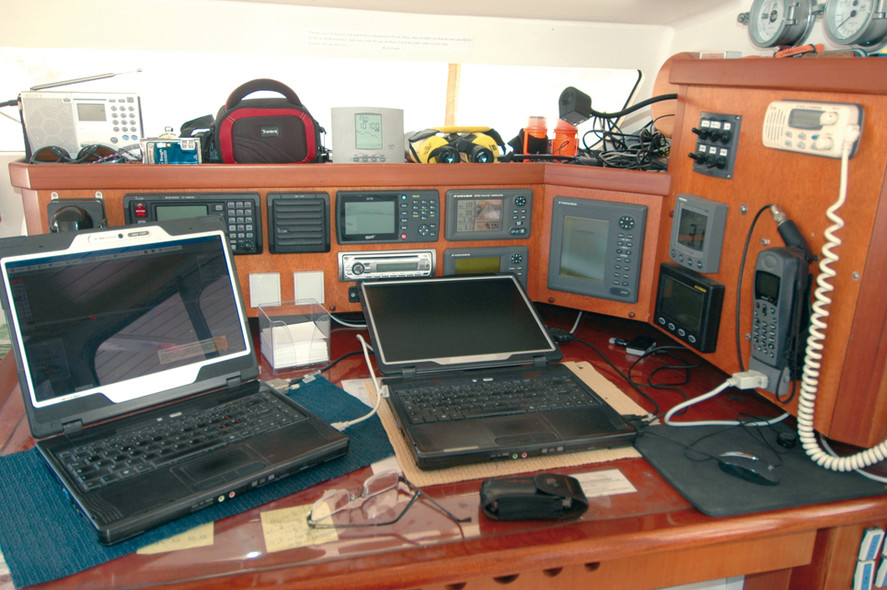
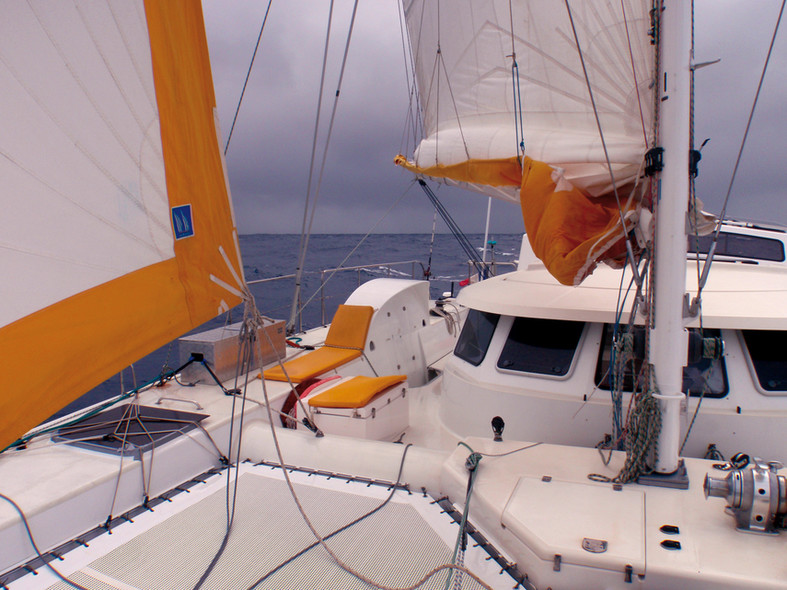
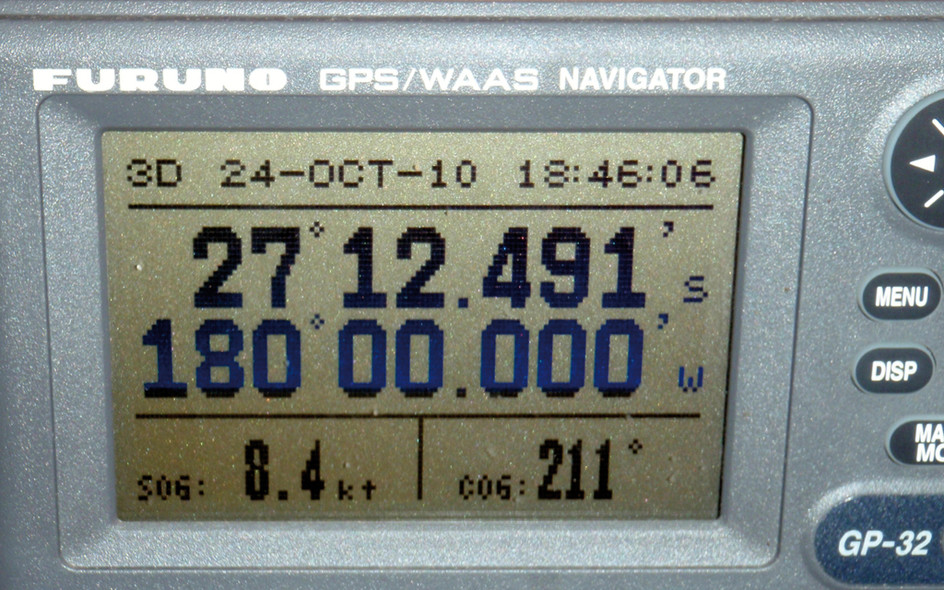
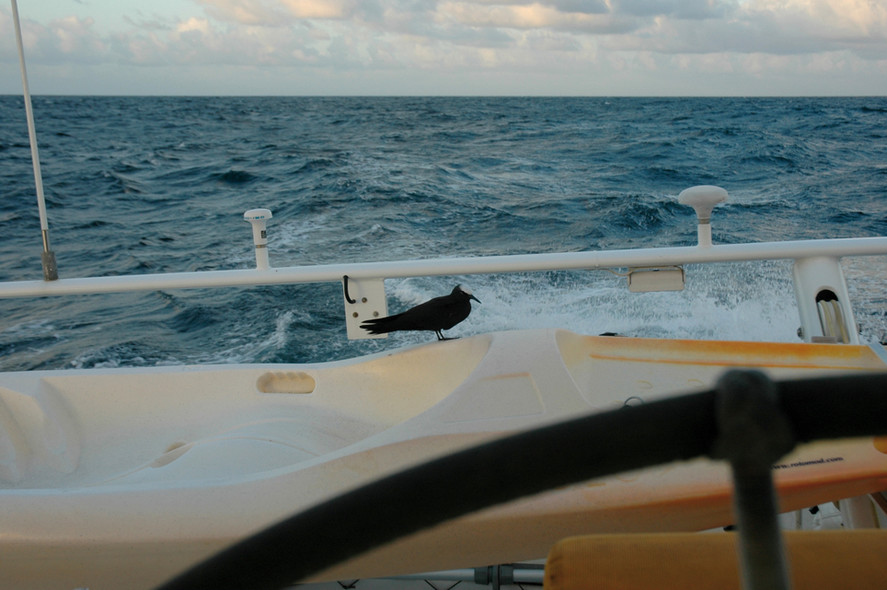
What readers think
Post a comment
No comments to show.